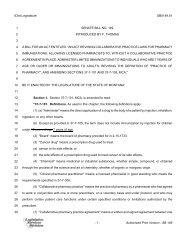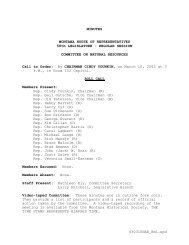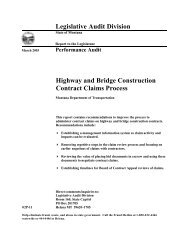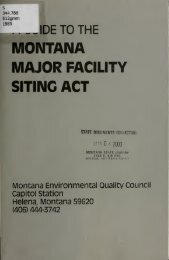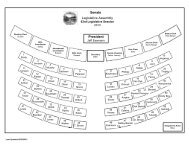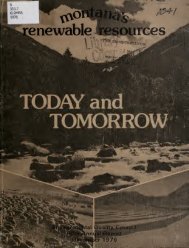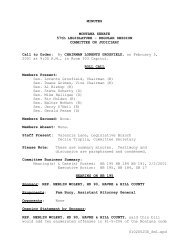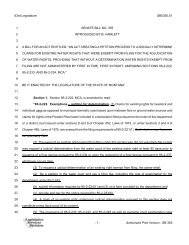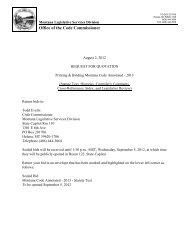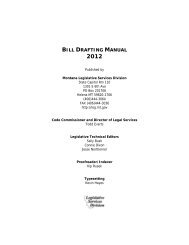Public Comment. Volume III - Montana Legislature
Public Comment. Volume III - Montana Legislature
Public Comment. Volume III - Montana Legislature
Create successful ePaper yourself
Turn your PDF publications into a flip-book with our unique Google optimized e-Paper software.
DRAFT, 4/9/85 28<br />
footed :. Ferrets ..."3 Ferret. presence,: is most .easily.. . . ...<br />
detected in late. summer - --. and ' dur i:ng.. winter .. tDecembe-r.-?.: ..<br />
1 - A 1 5 . The search along the Tongue River Railroad<br />
ROW should occur during the winter period, when<br />
evidence is most e'asily discerned.<br />
Colonies affected by the right-of-way should be<br />
searched at least once and preferably three times. ~ll<br />
colonies should be surveyed on foot, by walking transects<br />
spaced approximately 50 m apart back and forth<br />
across the colony, Any evidence of ferrets, such as<br />
digging, tracks, scats, skulls, etc., Epfiould be photographed<br />
and, where appropriate, collected. Scats and<br />
skulls s-hould be identified following the keys in the<br />
"Handbook." If ferret evidence is found, the proper<br />
authorities should be notified following procedures of<br />
the Endangered Species Act,<br />
(8) Similarly, although it is highly unlikely that nesting<br />
peregrine falcons will be found along the ROW, any<br />
occurrence of nesting activity should be properly<br />
recorded and reported,<br />
10,2,1 Mitigative Measures<br />
(1) Construction Timing, The primary method of impact<br />
mitigation for wildlife is timing construction activities;<br />
All reasonable attempts should be made to avoid<br />
construction at big game winteri'ng sites from December<br />
through March.<br />
(2) Fawning Sites, Timing of construction may be less<br />
effective in mitigating disturbance at "fawning sites,"<br />
because this term cannot be consistently applied to a<br />
given geographic location, That is, a site where deer<br />
or antelope fawns are born in one year may .not be used<br />
in the ., following year.<br />
Most fawns are born during the period May 15 - June 30.<br />
Late in the reconnaissance period, any single female<br />
deer or antelope that are observed should be assumed to<br />
be at or near a potential fawning site, The locations<br />
3 ~ , Clark, ~ . T.M. Campbell 111, M.H, Schroeder, and L.<br />
Richardson, "Handbook of Methods for Locating Black-footed<br />
Ferrets, " U. S. Bureau of Land Management, wiidlif e Technical<br />
Bulletin No. 1 (19831, Cheyenne, ~yoming,<br />
EQC Eminent Domain Study -21 1 -



